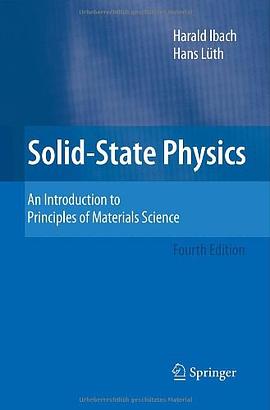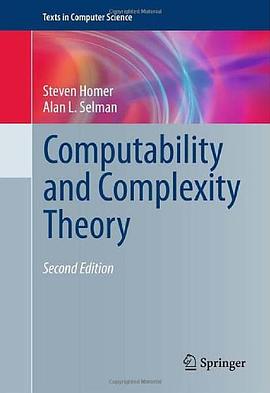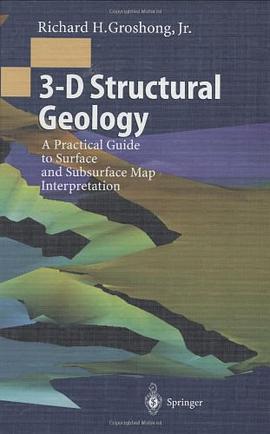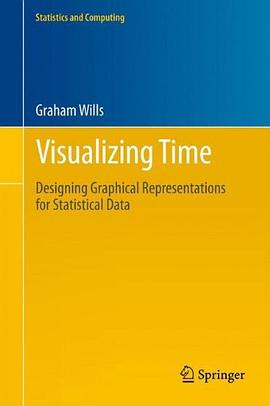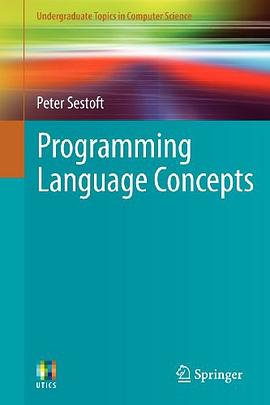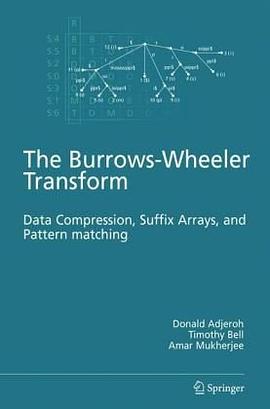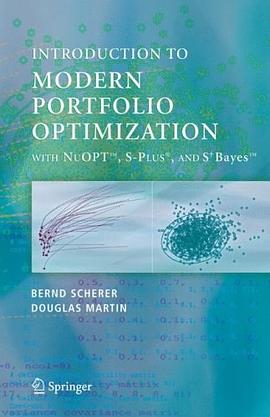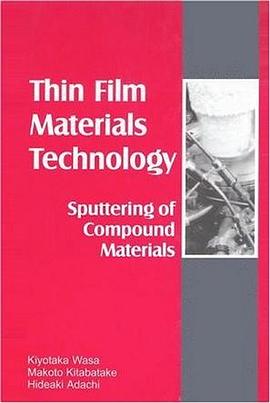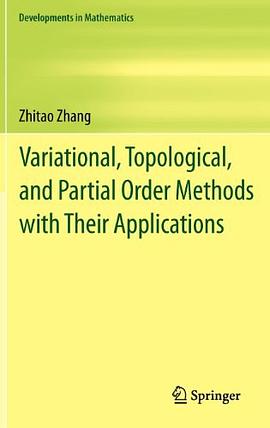
Variational, Topological, and Partial Order Methods with Their Applications pdf epub mobi txt 电子书 下载 2025
- 数学
- Springer
- 2012
- Variational Methods
- Topological Methods
- Partial Order Methods
- Optimization
- Mathematical Analysis
- Applied Mathematics
- Nonlinear Analysis
- Fixed Point Theory
- Functional Analysis
- Order Theory

具体描述
Nonlinear functional analysis is an important branch of contemporary mathematics. It's related to topology, ordinary differential equations, partial differential equations, groups, dynamical systems, differential geometry, measure theory, and more. In this book, the author presents some new and interesting results on fundamental methods in nonlinear functional analysis, namely variational, topological and partial order methods, which have been used extensively to solve existence of solutions for elliptic equations, wave equations, Schrodinger equations, Hamiltonian systems etc., and are also used to study the existence of multiple solutions and properties of solutions. This book is useful for researchers and graduate students in the field of nonlinear functional analysis.
作者简介
目录信息
1 Preliminaries . . . . . . . . . . . . . . . . . . . . . . . . . . . . . . . 1
1.1 Sobolev Spaces and Embedding Theorems . . . . . . . . . . . . . 1
1.2 CriticalPoint . . . . . . . . . . . . . . . . . . . . . . . . . . . . . 5
1.3 Cone andPartialOrder . . . . . . . . . . . . . . . . . . . . . . . . 11
1.4 BrouwerDegree . . . . . . . . . . . . . . . . . . . . . . . . . . . 12
1.5 Compact Map and Leray–Schauder Degree . . . . . . . . . . . . . 13
1.5.1 Definitions . . . . . . . . . . . . . . . . . . . . . . . . . . 13
1.5.2 Properties of Compact Maps . . . . . . . . . . . . . . . . 14
1.5.3 The Leray–Schauder Degree . . . . . . . . . . . . . . . . 15
1.6 Fredholm Operators . . . . . . . . . . . . . . . . . . . . . . . . . 17
1.7 FixedPoint Index . . . . . . . . . . . . . . . . . . . . . . . . . . 18
1.8 Banach’s Contract Theorem, Implicit Functions Theorem . . . . . 20
1.9 Krein–Rutman Theorem . . . . . . . . . . . . . . . . . . . . . . . 20
1.10 Bifurcation Theory . . . . . . . . . . . . . . . . . . . . . . . . . . 21
1.11 Rearrangements of Sets and Functions . . . . . . . . . . . . . . . 23
1.12 Genus and Category . . . . . . . . . . . . . . . . . . . . . . . . . 25
1.13 MaximumPrinciples andSymmetryofSolution . . . . . . . . . . 27
1.14 Comparison Theorems . . . . . . . . . . . . . . . . . . . . . . . . 28
2 Cone and Partial Order Methods . . . . . . . . . . . . . . . . . . . . 35
2.1 IncreasingOperators . . . . . . . . . . . . . . . . . . . . . . . . . 35
2.2 DecreasingOperators . . . . . . . . . . . . . . . . . . . . . . . . 45
2.3 Mixed Monotone Operators . . . . . . . . . . . . . . . . . . . . . 54
2.4 Applications of Mixed Monotone Operators . . . . . . . . . . . . 74
2.5 Further Results on Cones and Partial Order Methods . . . . . . . . 84
3 Minimax Methods . . . . . . . . . . . . . . . . . . . . . . . . . . . . 99
3.1 Mountain Pass Theorem and Minimax Principle . . . . . . . . . . 99
3.2 Linking Methods . . . . . . . . . . . . . . . . . . . . . . . . . . . 101
3.3 Local Linking Methods . . . . . . . . . . . . . . . . . . . . . . . 103
3.3.1 DeformationLemmas . . . . . . . . . . . . . . . . . . . . 104
ix
x Contents
3.3.2 The Three Critical Points Theorem for Functionals
Bounded Below . . . . . . . . . . . . . . . . . . . . . . . 107
3.3.3 Super-quadratic Functionals . . . . . . . . . . . . . . . . . 110
3.3.4 Asymptotically Quadratic Functionals . . . . . . . . . . . 112
3.3.5 Applications to Elliptic Boundary Value Problems . . . . . 116
3.3.6 Local Linking and Critical Groups . . . . . . . . . . . . . 121
4 Bifurcation and Critical Point . . . . . . . . . . . . . . . . . . . . . . 131
4.1 Introduction . . . . . . . . . . . . . . . . . . . . . . . . . . . . . 131
4.2 MainResultswithParameter . . . . . . . . . . . . . . . . . . . . 133
4.3 Equations Without the Parameter . . . . . . . . . . . . . . . . . . 141
5 Solutions of a Class of Monge–Ampère Equations . . . . . . . . . . . 143
5.1 Introduction . . . . . . . . . . . . . . . . . . . . . . . . . . . . . 143
5.2 MovingPlaneArgument . . . . . . . . . . . . . . . . . . . . . . . 145
5.3 Existence and Non-existence Results . . . . . . . . . . . . . . . . 149
5.4 BifurcationandtheEquationwithaParameter . . . . . . . . . . . 153
5.5 Appendix . . . . . . . . . . . . . . . . . . . . . . . . . . . . . . . 171
6 Topological Methods and Applications . . . . . . . . . . . . . . . . . 175
6.1 Superlinear System of Integral Equations and Applications . . . . 175
6.1.1 Introduction . . . . . . . . . . . . . . . . . . . . . . . . . 175
6.1.2 Existence of Non-trivial Solutions . . . . . . . . . . . . . . 175
6.1.3 Application to Two-Point Boundary Value Problems . . . . 185
6.2 Existence of Positive Solutions for a Semilinear Elliptic System . . 186
6.2.1 Introduction . . . . . . . . . . . . . . . . . . . . . . . . . 186
6.2.2 Existence of Positive Solutions . . . . . . . . . . . . . . . 189
7 Dancer–Fuˇcik Spectrum . . . . . . . . . . . . . . . . . . . . . . . . . 199
7.1 The Spectrum of a Self-adjoint Operator . . . . . . . . . . . . . . 199
7.2 Dancer–Fuˇcik Spectrum on Bounded Domains . . . . . . . . . . . 200
7.3 Dancer–Fuˇcik Point Spectrum on RN . . . . . . . . . . . . . . . . 204
7.3.1 Introduction . . . . . . . . . . . . . . . . . . . . . . . . . 204
7.3.2 The Trivial Part of the Fuˇcik Point Spectrum . . . . . . . . 205
7.3.3 Non-trivial Fuˇcik Eigenvalues by Minimax Methods . . . . 208
7.3.4 Some Properties of the First Curve and the Corresponding
Eigenfunctions . . . . . . . . . . . . . . . . . . . . . . . . 212
7.4 Dancer–Fuˇcik Spectrum and Asymptotically Linear Elliptic
Problems . . . . . . . . . . . . . . . . . . . . . . . . . . . . . . . 215
7.4.1 Introduction . . . . . . . . . . . . . . . . . . . . . . . . . 215
7.4.2 Proofs of Main Theorems . . . . . . . . . . . . . . . . . . 217
8 Sign-Changing Solutions . . . . . . . . . . . . . . . . . . . . . . . . . 221
8.1 Sign-Changing Solutions for Superlinear Dirichlet Problems . . . . 221
8.1.1 Nehari Manifold and Sign-Changing Solutions . . . . . . . 221
8.1.2 Additional Properties of Sign-Changing Solutions to
Superlinear Elliptic Equations . . . . . . . . . . . . . . . . 226
Contents xi
8.2 Sign-Changing Solutions for Jumping Nonlinear Problems . . . . . 231
8.2.1 On Limit Equation of Lotka–Volterra Competing System
with Two Species . . . . . . . . . . . . . . . . . . . . . . 231
8.2.2 On General Jumping Nonlinear Problems . . . . . . . . . . 235
8.2.3 Sign-Changing Solutions of p-LaplacianEquations . . . . 244
8.2.4 Sign-Changing Solutions of Schrödinger Equations . . . . 246
9 Extension of Brezis–Nirenberg’s Results and Quasilinear Problems . 249
9.1 Introduction . . . . . . . . . . . . . . . . . . . . . . . . . . . . . 249
9.2 W
1,p
0 () Versus C1
0 ( ¯ ) Local Minimizers . . . . . . . . . . . . . 251
9.3 Multiplicity Results for the Quasilinear Problems . . . . . . . . . 253
9.4 Uniqueness Results . . . . . . . . . . . . . . . . . . . . . . . . . 267
10 Nonlocal Kirchhoff Elliptic Problems . . . . . . . . . . . . . . . . . . 271
10.1 Introduction . . . . . . . . . . . . . . . . . . . . . . . . . . . . . 271
10.2 Yang Index and Critical Groups to Nonlocal Problems . . . . . . . 272
10.3 Variational Methods and Invariant Sets of Descent Flow . . . . . . 278
10.4 Uniqueness of Solution for a Class of Kirchhoff-Type Equations . . 282
11 Free Boundary Problems, System of Equations for Bose–Einstein
Condensate and Competing Species . . . . . . . . . . . . . . . . . . . 285
11.1 Competing System with Many Species . . . . . . . . . . . . . . . 285
11.1.1 Existence and Uniqueness of Positive Solution . . . . . . . 285
11.1.2 The Limit Spatial Segregation System of Competing
Systems . . . . . . . . . . . . . . . . . . . . . . . . . . . 290
11.2 Optimal Partition Problems . . . . . . . . . . . . . . . . . . . . . 291
11.2.1 An Optimal Partition Problem Related to Nonlinear
Eigenvalues . . . . . . . . . . . . . . . . . . . . . . . . . 291
11.2.2 An Optimal Partition Problem for Eigenvalues . . . . . . . 295
11.3 Schrödinger Systems from Bose–Einstein Condensate . . . . . . . 298
11.3.1 Existence of Solutions for Schrödinger Systems . . . . . . 300
11.3.2 The Limit State of Schrödinger Systems . . . . . . . . . . 310
11.3.3 Cα Estimateof theSolutionsofParabolicSystems . . . . . 316
References . . . . . . . . . . . . . . . . . . . . . . . . . . . . . . . . . . . 319
Index . . . . . . . . . . . . . . . . . . . . . . . . . . . . . . . . . . . . . . 329
· · · · · · (收起)
读后感
评分
评分
评分
评分
用户评价
Front research in this field New results about this topic Theory and applications are shown together
评分Front research in this field New results about this topic Theory and applications are shown together
评分Front research in this field New results about this topic Theory and applications are shown together
评分Front research in this field New results about this topic Theory and applications are shown together
评分Front research in this field New results about this topic Theory and applications are shown together
相关图书
本站所有内容均为互联网搜索引擎提供的公开搜索信息,本站不存储任何数据与内容,任何内容与数据均与本站无关,如有需要请联系相关搜索引擎包括但不限于百度,google,bing,sogou 等
© 2025 book.quotespace.org All Rights Reserved. 小美书屋 版权所有


